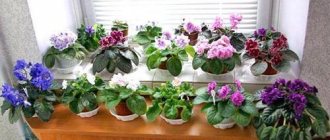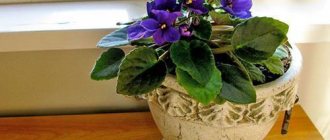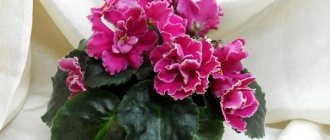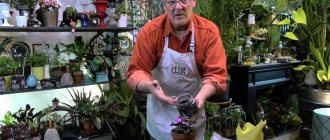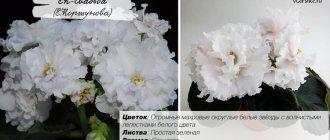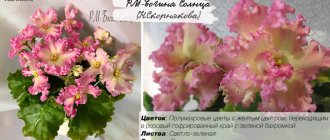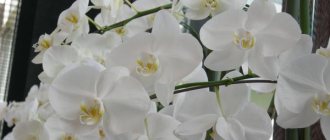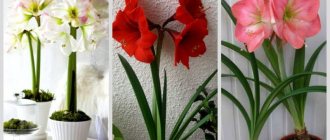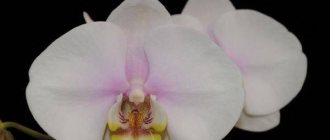Uzambara violets, which appeared in the collections of USSR flower growers just over fifty years ago, have changed dramatically during this time.
If our mothers and grandmothers rejoiced at the appearance of simple purple, pink or white flowers, today on the windowsills next to blooming pelargoniums and unique lithops flaunt luxurious fantasy violets of all shapes, sizes and shades. Sometimes, studying the modern names and photos of varieties of indoor violets, it is difficult to assume that these are direct descendants of the modest inhabitants of the South African mountain forests.
Violet African night
Large rosettes of the African Night violet are easily recognized among the many brightest and most unusual plants. The thing is that the breeder Konstantin managed to create a unique variety that amazes with giant velvety flowers, like the southern night sky, more like black stars on violets. The plant forms a neat standard rosette of simple dark green foliage with a noticeable purple tinge on the back.
Flowering is stable and very long. When grown, it does not cause any trouble to the grower; the variety does not require special care.
Forest violet: description and photo
Like most other flowers, the genus of violets has many specimens, many of which are forest dwellers.
Some species that do not grow in the forest are also classified as tree violet.
The purple forest name refers to the tricolor variety. This variety became the basis for the opening of a pet in flower beds - “Pansy”.
Below you will see pictures of wild violets.
Attention! Other species classified as forest are simply similar to this one or have similar habitats.
Varieties of varieties
There are a lot of wild violets on the list. It is worth highlighting those that are especially popular among gardeners. Between them:
- Forest tricolor;
- Canine;
- Pantano;
- Fragrant;
- Altai;
- Ethical;
- Stop;
In the forests you can find various beautiful violets.
- Engraving;
- Hairy;
- Reifenbach;
- Rivinio;
- Palm shaped and others.
Most purple flowers are difficult to find in nature; they remain only in flower beds. Many species are already listed in the red books, both territorial and international. There are also varieties that could be found until recently but are now considered extinct. But at the same time, the wild forest violet grows.
Distribution area
The distribution halo of violets is very wide. There are varieties in the Americas, most grow on the Eurasian continent, but the fewest species grow in Africa and Australia.
Most woodland varieties are native to Europe, with a few species from America and Asia.
The main part, depending on the species, prefers forest, swampy and mountainous areas. A photograph of flowers is shown on the left.
Description
Like all beautiful flowers, violets have their own history, or rather two legends that the Greeks took possession of them.
According to the first legend, Zeus created the viola. A gentle nymph, fleeing from Apollo, asked for protection from the supreme god. Protecting the girl from the sun's rays and heat, Zeus turned her into a beautiful flower and hid her in the shade, under a bush.
There he grew up and was only pleasing to the eye, but one day Persephone came across a beautiful plant. He picked up a beautiful bouquet, and on the way home Hades stole it, and the bouquet crumbled. Thus, beautiful flowers spread across the earth and began to grow in the shade, bringing joy to all people.
The second legend speaks of the involvement of the goddess of love and beauty Aphrodite in the appearance of flowers. The beauty wanted to swim and noticed the men who were spying on her.
The angry goddess suggested that Zeus condemn the perpetrators and asked him to kill them. But the supreme god took pity on the mortals and freed them, but as punishment he turned them into flowers that looked like eyes.
All varieties of violets belonging to the forest are similar to each other. Most violets are considered herbaceous plants and have small flowers. Flowers in most cases have five or six petals, three of which are directed downwards, and another two or three upwards, the upper ones are slightly larger than the lower ones, but the lower central one is the largest.
Important! The color of violets can be different, but among all varieties it is purple and its shades that predominate.
Beneficial features
Many varieties of violets, including wild ones, have beneficial properties. Wild violets are used for respiratory and skin diseases.
Violet stimulates increased secretion of glands in the bronchi, thins mucus and inflammatory plaque, promoting their rapid elimination. It also extinguishes inflammatory processes with the help of essential oils, which are part of the above-ground part of the plant.
The herb also contains substances that stimulate the secretion of urine and sweat, which, in turn, improves metabolism in the body.
The properties of wild violet allow it to be used not only in folk medicine, but also in traditional medicine. Infusion and decoction of the upper part of the plant is used for:
- Tracheitis;
- Bronchitis;
- Choking cough;
- Pneumonia;
- And other diseases, the treatment of which requires the removal of sputum from the lungs.
A decoction of herbs in folk medicine is used for diathesis and other rashes. Anti-inflammatory and antiseptic effect helps reduce skin irritation.
Important! Children are washed in a weak decoction of forest violets. This plant is used both independently and in mixture with other plants used for this purpose.
Bloom
Not everyone knows when forest violets bloom. Different varieties bloom at different times, but most often in the spring and very early. Most violets bloom in several passes, so flowering usually lasts until late autumn.
Varieties common to mid-latitudes usually bloom in late April-May in flatter areas.
All varieties bloom at different ages. Most are perennials, some varieties are biennial and some are annual. Depending on the variety, the first flowering occurs:
- Annuals - germinate in the spring from last year's seeds, having reached the required size and development, form flower stalks, after flowering they form pods and sow again;
- Biennial: Depending on the variety, they bloom in the year of sowing or the following year. Blooms in spring. If flowering is necessary in the same year, the seeds are sown on seedlings and then planted;
- Perennials: Bloom most in their second year. Flowers appear only in spring. You can get quick flowering; the seeds are sown in early autumn so that they sprout and get stronger by winter.
Growing in garden plots
Forest beauties are planted in different compositions in flower beds, rock gardens and pots. Most shrubs prefer shade or partial shade. The most popular tricolor forest violets,
and their ornamental cousins, pansies, which grow in both sun and shade.
Sowing is carried out in spring or autumn. If the seedlings are grown, they are sown according to the required flowering period. Florists plant seedlings in open ground or transplant them into spacious pots.
Caring for a flower does not require additional actions. In spring, it is recommended to water young bushes. Fertilizing is carried out in the spring, sometimes in the summer, fertilizing is carried out so that re-blooming occurs.
Violet Ness Orange pekoe
Fans of variegated and unusual varieties will definitely pay attention to the Ness Orange pekoe violet, which generously bestows its owners with double or semi-double flowers of a luxurious salmon hue. Such corollas look especially impressive against the background of dark green leaf blades, edged with all tones of white and pink. The underside of the leaves has a pronounced red tint.
Features of caring for Le Magenta violet at home
In order for a flower to delight its owners with lush inflorescences, bright colors and constant growth, appropriate care is necessary. In this regard, Saintpaulia Magenta has certain features.
Temperature
Violet Fairy - description and characteristics of the variety
The optimal temperature range is +18-25 degrees Celsius. At low temperatures, the plant rots; at elevated temperatures, it leads to the formation of aphids.
To avoid problems in winter, it is recommended to place a 3-centimeter layer of insulation under the pot on the northern window sill (the simplest option is polystyrene foam).
We must not forget about ventilation: fresh air is the key to successful germination.
Lighting
Here the situation is this: bright light is needed, but direct sunlight is prohibited. Aggressive exposure to the sun leads to burns of the leaves, so you should resort to diffused lighting.
Additional Information! During short daylight hours, additional illumination through artificial lamps is needed.
While it is winter, the flowerpot feels calm on the south side.
Features of violet care at home
However, with the arrival of hot weather, it is better to move the Le Magenta violet to an eastern or western windowsill.
Feeding
It is recommended to feed the plant with useful substances twice a month. While violets have a dormant period (November-February), the amount of fertilizing should be reduced to once every 40-50 days.
On a note! Good examples of fertilizers are products under the Stimovit, Baikal, and Master brands.
Fertilizers are applied to pre-moistened soil (certainly after watering). They use complexes of minerals.
Watering, spraying and humidity
The moisture level in the air should reach 55-65%. Lack of humidity can be solved in two ways:
- spraying the space around the pot;
- humidifier.
The water should be at room temperature - within 22-24 degrees.
There are three watering methods:
- Lower. A deep vessel is needed here. Fill the taken container with water and place the pot with violets at ¾ of the height. Darkening of the top layer indicates that the soil is saturated with moisture.
- Drip. A syringe or watering can with a narrow nose is used. The soil is watered without touching the growing point and leaves.
- Wick. One end of a piece of natural fiber rope passes through the drainage hole in the pot, the other is lowered into a container of water. So, the roots will take only the amount of liquid that is necessary for growth.
Watering is an important component of care. The procedure is carried out as the soil dries. The main thing is to make sure that the soil is not flooded or completely dry.
Priming
Magenta violet grows well in special purchased soil or in a homemade substrate. In order to “prepare” a suitable soil, you need to mix four ingredients in equal proportions:
- peat;
- crushed sphagnum moss;
- leaf soil;
- humus.
Terry leaves and a bright violet flower captured in macro photography
The resulting mixture is thoroughly mixed through a strainer.
Attention! The soil must be calcined before use. This is done in the oven at 100-200 degrees for thirty minutes.
This removes small debris, the remains of some roots and breaks up the formed lumps. The resulting combination is loose and soft, with no foreign elements or unwanted organic residues.
Violet Pink watercolor
The authorship of Konstantin Morev includes many interesting varieties, loved by many flower growers in Russia and neighboring countries . Violet Pink watercolor is rightfully one of the most popular. Large semi- or double white flowers have airy petals wavy along the edge with light, really pink watercolor strokes in the center. The edge of the petals is decorated with a white border. Violet leaf Pink watercolor, as in the photo, dark green with a white or cream border.
Violet Black Pearl
The spectacular violet Black Pearl, in the photo, was bred by E. Korshunova and received many flattering reviews both at Saintpaulia exhibitions and from ordinary lovers of these plants. The variety stands out both for the size of its large, densely double star-shaped flowers and for their rich velvety color, with tints of violet and purple shades. The rosette is formed of standard sizes, the foliage is dark green, oval, on long strong petioles.
When propagating the Black Pearl violet, flower growers sometimes encounter unusual mutations, sometimes leading to uniquely beautiful flowers, as in the photo.
